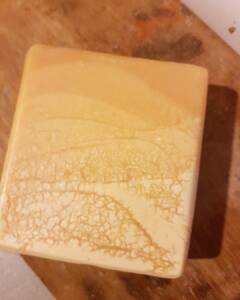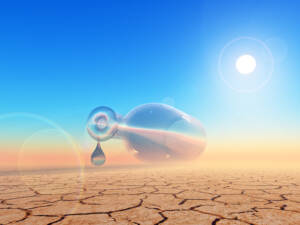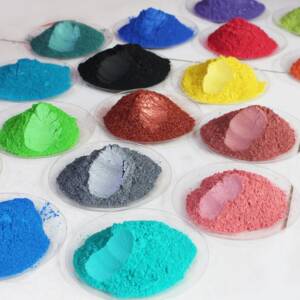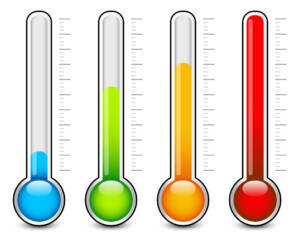Whether you are new to soap making or have a bit of experience under your belt. Sooner or later you will experience this phenomenon known as glycerin rivers. Your next question when you do experience it will be what went wrong.
Here is culprit to what causes glycerin rivers in cold process soap.
This one change can reduce glycerin rivers.
Ok yes there are a few factors that will cause glycerin rivers to show up in your soap but there is one change you can do to reduce and even prevent them from ever forming.

This took a while to figure out but the longer you soap, test new recipes and techniques you tend to pick some unspoken habits. These habits over time will help you develop a technique that works great for you and produces a good solid bar of soap.
This habit I picked up unknowingly was good enough that I did not realize that I was no longer getting glycerin rivers in my soaps, yet its so simple.
Water… that’s it. Water is often the main culprit to the formation of glycerin rivers in your soap. Well yes we do need water so you cant just leave it out of your recipe but you can reduce the amount you add to your recipe and that will make all the difference.
A water reduction also known as water discount in soaping terms, will make a great improvement however the other variables will have to be adjusted as well. Lets take a look at how your recipe will be affected to avoid glycerin rivers
What is glycerin river in cold process soap making?
Glycerin rivers are those weird lines of opaque soap that run through your soap. They can be thick or thin and some can make it look like your soap is cracking with intricate details.
These rivers are not flowing rivers but actually a point where the color or pigment you use in your soap separates from the soap batter while the natural formation of glycerin which forms during the saponification process fills the spaces.
This is actually pure glycerin in a solidifies state. this is what draws moisture to your skin when you use the soap and what soapers, natural or commercial strive to have their bar of soap do.
Will glycerin rivers affect my soap performance?
No, glycerin rivers do not adversely affect the overall performance of your soap. It will clean as normally as if there were no visible glycerin in your soap.
As a matter of fact its good to know that your recipe is producing good glycerin in your soap. This glycerin is the magic ingredient that makes a good bar so soothing to the skin.
After taking a shower or bath most soaps strip the skin of its natural oils but by having this glycerin in your soap which is a natural occurrence due to the chemical reaction, it will help hydrate your skin by attracting moisture to your skin.
Soaps that dry out our skin are obviously not good for you so just know that this is a good thing
How to reduce the chances of forming glycerin rivers?
The reduction or even removal of visible glycerin rivers in your soap is possible if you pay attention to all the culprits that cause its formation.
Although I have found that water is the main contributing factor, the others also play a role if they are not monitored or the incorrect amount is added to your soap batter.
This reduction of the rivers will require you to tweak your soap recipes a bit to gain the desired affect but it will not affect the end function of your soap and its benefits.
Water Discount

I mentioned this before that over time i realized that water seemed to be the major contributing factor to the formation of glycerin rivers. Hence the best way to combat this issue is to reduce the amount of water in your soap recipe.
A reduction of water doesn’t necessarily affect your soap formation, remember lye does that. Using the correct amount of Lye to convert the type and amount of oils in your recipe to soap is what is the most important part of soap making.
Water is used to create lye water which then reacts with the oils to start the saponification process.
The reduction of water doesn’t affect your end soap performance as its the lye that does that.
**Warning**
I must advise you however, that reducing the amount of water used in your lye water solution will cause your lye water mixture to be super heated. Hotter than what you may have been used to.
Normally lye solution would reach slightly above 200 degrees however I have seen temperatures reach well over 250 degrees.
Color ratios
When adding various colors to your soap the amount and the type of colorant will and can make a difference when it comes to rivers.

Firstly there are various types of colorants from natural, pigments, clay or mica. Each has its uses in coloring cold process soap. Some colorants are lighter and thinner than others. Which means the heavier materials will act differently.
Titanium dioxide for example is known for causing rivers in soap its as if it somehow attracts it.
No need to worry as there is a solution to this problem. A quick tip is to make sure you mix your colorant before hand either in oil or water depending on the type of colorant.
Mixing it prior to adding it makes sure all clumps have been removed and it disperses the powder better before being added to your soap mixture. This simple technique will save you time and help avoid the development of rivers.
Blending Technique
This may come as a surprise to some soapers but temperature does matter all the way through your soaping technique.
When I say your blending technique I do not mean how you make your lye water as that’s pretty strait forward especially if you follow safety protocols.
What I am referring to is the way you add your lye water to your oil.
Temperature is critical and a major component to causing glycerin rivers. The heat of the oils and lye water together continues to rise as the chemical process turns the fats into soap.
If you add your lye water to your oils at a high temperature you are asking for more than just glycerin rivers you may cause your soap to volcano. If it doesn’t there is a good chance it may crack and deep within the soap rivers will be formed.
The heat tends to separate the colorant from the oils causing glycerin to fill in the gaps and in some instances it can cause the glycerin to attract into the middle of the soap where it is the hottest because its the softest part when it comes to heat.
Let your lye water cool down to a manageable temperature when adding it to your oils a good temperature is between 90 and 100 degrees. You can also have your oils close to this temperature as well.
This is just a guide line as some techniques require hotter temperatures while other require lower temperatures.
Monitor the heat

As I mentioned before adding your lye water to your oils at high temperature can cause some issues with your soap.
So this is where you have to baby sit your soap while the chemical reaction subsides, there are some caveats to this however. Some soapers will say put your soap to bed while others say not to. Well it depends on your location in the world and the ambient temperature of the room you will keep your soap.
I found this out over time that although we are in the Caribbean, the winters do not get super cold but they get cool enough to affect the outcome of my soap.
Room Temperature
I learned soap making in the winter so when I was done making the soap I would put it to bed by covering it with towels to keep the heat cooking the soap.
When summer came around however, using the same recipe and technique my soap began to crack or swell up as if it was act like a volcano. What I realized is the ambient temperature plays a pivotal role on whether you will put your soap to bed or not.
Until you get an idea of how your seasons affects your soaping area it is a good idea to baby sit your soap by checking the temperature every 20-30 minutes.
If it seems as if it is getting to hot to quickly and begins to crack you can place it in the refrigerator for 5 minute intervals to bring down the temperature.
If it seems as if the temperature is too cool like nearer to room temperature, they you may want to either put your soap to bed by covering it or place it in the oven for a few minutes.
**NOTE** there are various technique to placing your soap in the oven. Some people heat it to 100 deg then turn the oven off and let the reducing heat keep the soap warm. Others place in the oven at a lower temp for a few minutes.
What or where ever you may be you will need to monitor your soap temperature. If it begins to heat up a few degrees chances are it will crack and in the middle glycerin rivers are forming.
Glycerin rivers are they good or bad?

At the end of the day you have to determine if having glycerin rivers in your soap is good or bad thing.
It is purely aesthetic and does not affect the ability of your soap to clean your skin thoroughly.
Some soapers prefer to have it and can use it as decoration by adding varying amounts of water and colorant to get a desired effect.
Soaps can all be unique from batch to batch and this can become something that is unique to your soap.
On the other hand you may be a perfectionist and find the rivers to be distracting and ugly. In this case you will want to do whatever you can to avoid them appearing.
Is purely a personal matter if you want them or not so don’t feel as if you are doing anything wrong. After all its your soap and your craft you can do with it as you please.
If you liked this article take a look a few more related articles below. Leave a comment or ask a question via the comment box or our email. We would be more than happy to answer you questions.
